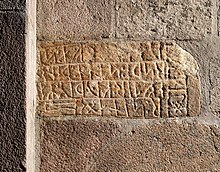Runestone from Hanning
The runestone of Hanning (DR 48) is located about 8.0 km north of Skjern in Jutland in Denmark . It comes from the post -Viking era and shows the representation of Mjölnir , the hammer of the Nordic god Thor .
The preserved part of the inscription on the rune stone consists of four horizontal and one vertical lines on a granite block of 1.1 × 0.5 m. The stone described in the 12th century was used in the construction of the church in Hanning. Although the rune stone was clearly visible in the southern choir wall for several centuries , it was first mentioned in 1843. As the stone was slammed for use in the wall, some of the text was lost. It sits horizontally in the wall of the choir, about 2.5 meters above the floor. The inscription shows a hammer within the runic text, Old Norse sina (sound same as "to be"), which was interpreted as Thor's hammer.
Due to the dating of the inscription to the 12th century and a linguistic analysis, which also points to a time of origin about 200 years after the Christianization of Denmark, the question was raised whether the hammer is actually a testimony to paganism. It has been suggested that the hammer is a symbol of a blacksmith. However, there are no parallels to such symbolic representations on other medieval rune stones, and the hammer is very similar to that on DR 26 in Laeborg, which is considered to be a reliable representation of Mjölnir.
Thor's hammer was used on several rune stones in Sweden and Denmark, possibly as a pagan response to the use of the cross by Christians. Other surviving rune stones or inscriptions showing Thor's hammer in Sweden are the seven rune stones U 1161 in Altuna, Sö 86 in Åby, Sö 111 in Stenkvista, Sö 140 by Jursta, Vg 113 in Lärkegapet, Öl 1 in Karlevi, DR 331 today in Lund ( Scania ) and in Denmark the two stones DR 26 in Laeborg and DR 120 in Spentrup.
The inscription is arranged in parallel rows, it begins in the lower right corner. It ends in the middle of the stone below after the sequence "his mother". Some runes seem to have been colored like the oddly carved Oddum or Ådum stone (DR 46). The inscription indicates that the stone was raised by a man, possibly called Vagn, who was the son of Tófis, to commemorate his mother Gyða. The vertical line probably names the rune master who cut the runes .
The text reads: “<ua ->, Tófi's son, raised this stone in memory of Gyða, his mother. ... kell (cut) ”.
literature
- Erik Moltke : Runes and Their Origin: Denmark and Elsewhere . Copenhagen 1985: National Museum Forlag. ISBN 87-480-0578-9
Coordinates: 56 ° 1 ′ 8.6 ″ N , 8 ° 30 ′ 44.5 ″ E

